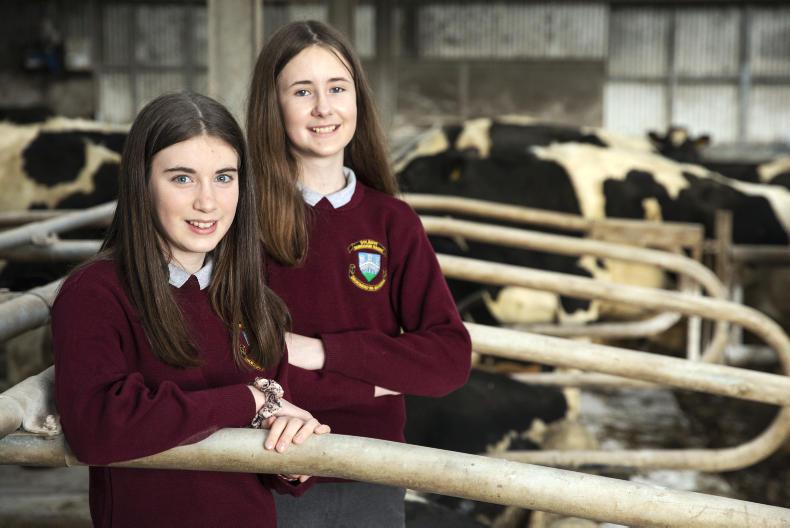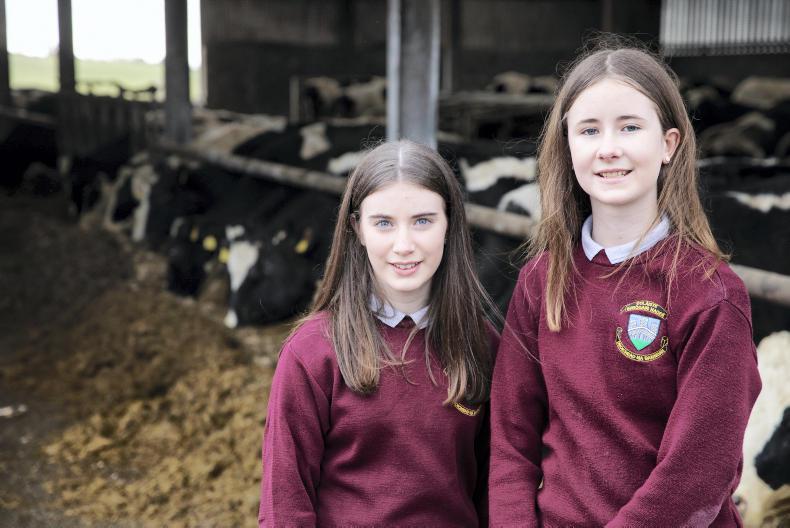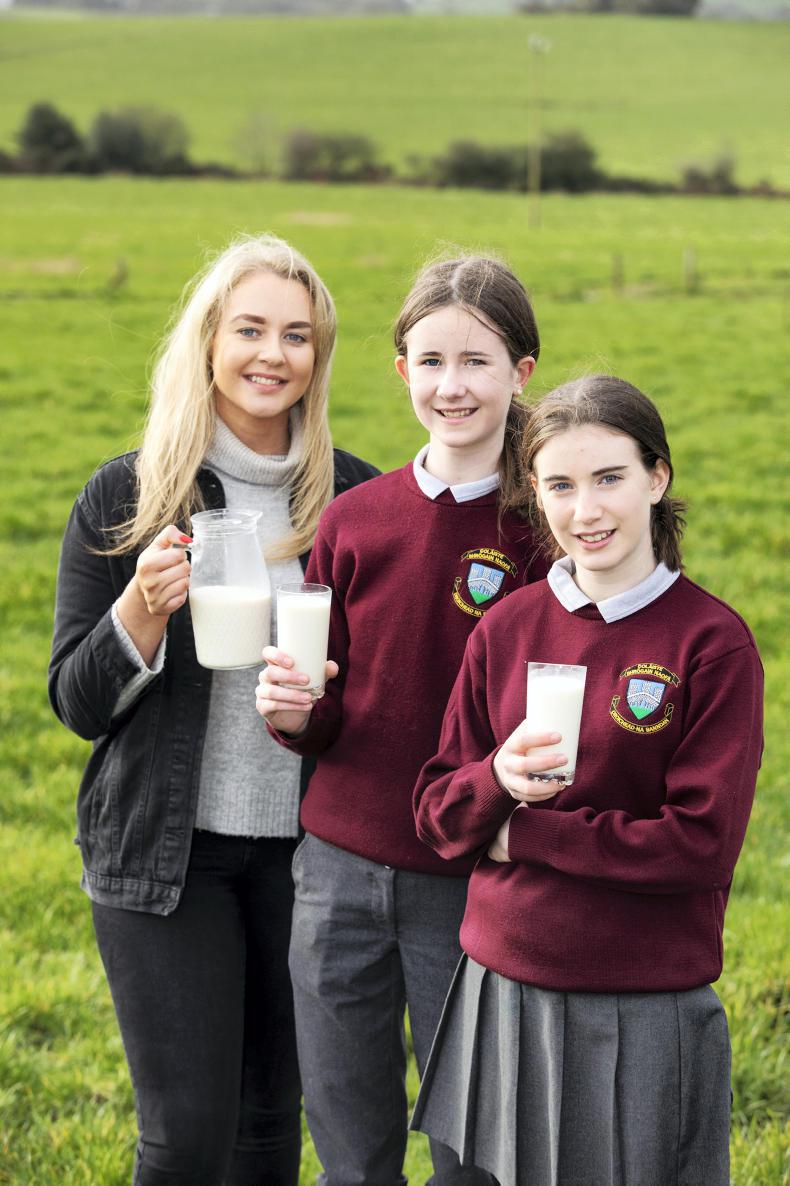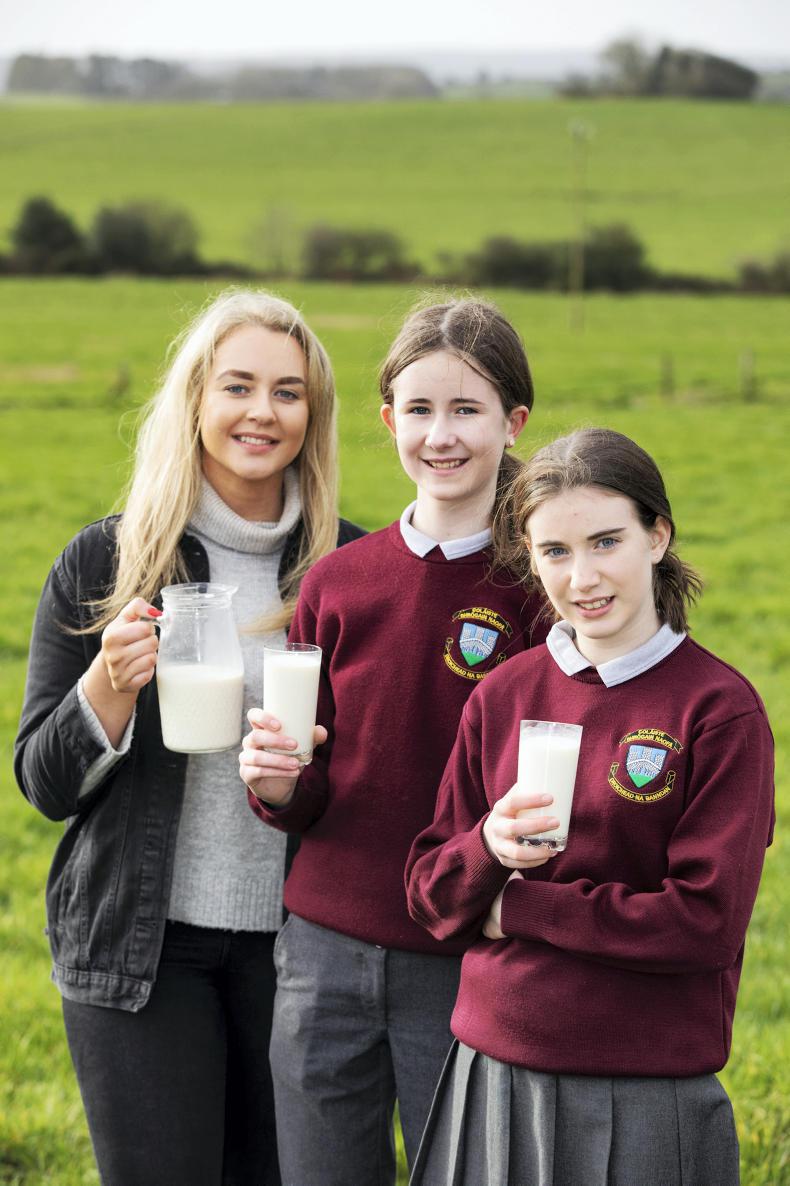What were you doing at age 13? All I seem to be able to remember is never having “cool enough” clothes and trying to understand French immersion social studies (the Canadian junior high school system isn’t all it’s cracked up to be). I’m fairly certain I wouldn’t have been able to complete months worth of research, with all relevant citations, in mere weeks.
Listen to "Students set out to change the perceptions around dairy consumption" on Spreaker.
I wouldn’t have been mature enough to understand the importance of nutrition within my age group. And I certainly couldn’t have put together an entire project to present at the BT Young Scientist Exhibition.
This, however, is precisely what St Brogan’s College students Kate O’Leary and Caoimhe Walsh (with the guidance of home economics teacher Karen Corbett) accomplished just weeks ago – all at the tender age of 13.

Living and attending school in Bandon, Co Cork, the girls are both daughters of dairy farmers and are passionate about agriculture. It was this passion that led them to their BT Young Scientist topic in nutrition. They noticed many of their peers weren’t eating a variety of healthy foods and, specifically, that many of them refused dairy products. Some wouldn’t eat dairy for environmental reasons while others believed dairy consumption would cause things like weight gain and bad skin.
“Our project was an investigation into the nutritional knowledge and consumption of calcium in female adolescents in the age range of 14 to 16,” says Caoimhe. “This is such a vital period of growth and development and [young girls] really need to get enough calcium in their diets. If they don’t, they can get osteoporosis and other deficiencies in later life. We found out that most girls aren’t getting enough calcium in their diets so we tried to increase this through experimental methods.” 
The latest consumer research from Bord Bia tells us that milk consumption at evening meals among children has fallen 11% since 2011; while Kate and Caoimhe’s preliminary research showed that 48% of those surveyed felt dairy consumption was only somewhat important or not important. Seeing these results and how these opinions were largely driven by misinformation, Caoimhe, Kate and Karen organised, with permission from St Brogan’s principal, a dairy awareness day at their school.
“We hosted a How Dairy You? awareness day where we gave out samples, we also made a website and designed a leaflet and then we saw a drastic change in results,” Caoimhe explains.
“We contacted companies and asked them to provide us with samples or information that we could use for our dairy awareness day,” Kate says. “We only expected one or two companies to come back to us, but we actually ended up getting six or seven.”
These companies included Carbery, Dairygold, Murphy’s Ice Cream, Fruchee, Bandon Co-op, Irish Yogurts Clonakilty and the National Dairy Council. As part of their research, Kate and Caoimhe also included interviews with representatives of Agri-Aware, product development scientists at Future Nutrition and a senior CORU registered dietician.
Their teacher Karen coached them in developing their overall project and oversaw the research. She was extremely impressed with the girls’ strong work ethic.
“There were 21 projects in the girls’ category,” she explains. “So within their category, there was first, second and third place. [Caoimhe and Kate] got highly commended, along with one other project. The girls got highly commended because of the amount of research they put into their project. It’s such a prestigious competition; and they’re only 13.”
The results
During their How Dairy You? day, Caoimhe and Kate handed out information leaflets about calcium intake and shared the website they had developed. Then, they handed out samples they had received from the participating businesses.
To their delight, the awareness campaign was a complete success – the students enjoyed the products they tried and, taking a look at the data collected after the event, many completely changed their attitude toward dairy and dairy products as a result.

Caoimhe Walsh and Kate O’Leary with their home economics teacher Karen Corbett. \ Donal O’Leary
“Seventy-six and a half per cent of those surveyed originally believed that consuming dairy products could have negative effects on physical health,” Karen says.
“Then, afterwards that changed to 76% believing it didn’t cause any [negative health effects], so it was almost a complete swap after the campaign,” Caoimhe finished.
Influencers and diets
Social media is a huge part of the lives of adolescents and, unfortunately, many are on the receiving end of pseudoscience and misinformation. Anyone can be an Instagram influencer – you don’t need a degree in nutrition to gain a large, online following. But many young, impressionable women follow these influencers, who often give the impression that anyone can look slim and beautiful, like them, if they give up carbohydrates or dairy products.
Irish Country Living spoke with Louise Reynolds, who is a registered dietician and the communications manager at the Irish Nutrition and Dietetics Institute, about the girls’ BT Young Scientist project. She feels that social media can be a serious problem for adolescent girls.

“Very often, you’ll find younger people are attracted to [online] influencers who have the desired body shape,” she says.
“Their message is usually, ‘If you do this, you’ll look like me’, and that’s actually nonsense because everyone has their own different genetic make up. These people may be exercising all day long or have eating disorders.
“A number of influencers have eventually come out to say that their interest in nutrition started because they have an eating disorder. They may have a skewed attitude toward food and nutrition.
“If young people don’t have someone constantly reminding them of this, they may think they’re not good enough unless they’re doing what [those influencers] say on their Instagram feed.”
Caoimhe and Kate agree that Instagram and other social media streams play a huge role in the way adolescents perceive food and nutrition, but they also think that social media has huge potential to get the correct message across.
“One of the main things we got back from our questionnaire and research was around social media advertising,” says Caoimhe. “Students feel that more positive advertising on social media would make a big difference (to how they perceive dairy).”
Twenty-one per cent of those surveyed after the How Dairy You? awareness day said that advertising on social media streams would improve the marketing strategies of Irish dairy companies, while 32.5% said that creating teen-focused product ranges would also help. Karen believes that simply opening up this topic at St Brogan’s is a step in the right direction for improving teenage diets.

“I see a lot of teenage girls skipping breakfast, going vegan and trying to reduce their fat intake, and they’re actually just cutting out all of these really important nutrients that come from meat and dairy,” she says.
“From my point of view, I feel it’s really important to educate them so they understand it’s important to have a balanced diet and they can’t cut out these nutrients in their diet – because it does have detrimental effects for their future.”
Awareness, not conversion
Although Kate says they didn’t convert any vegans with their How Dairy You? campaign, they did bring more awareness to vegan students about the importance of calcium and how they can incorporate more calcium into their diets.
“We found out that you can get calcium from kale and from cereals, but you’d have to eat like nine bags of kale and six whole fish to get the right amounts in your diet,” she laughs.
“No one would be eating that on a daily basis. Veganism is a big trend these days. [People] think they can take supplements, but that’s just giving you the calcium, not the full range of benefits you get from milk, which is the most efficient way to get calcium into your diet.”
Vegan or not, the How Dairy You? model was extremely successful on a local level. The girls not only increased the understanding of calcium intake and dairy among their peers; they eradicated many of the misconceptions commonly associated with dairy consumption.

In May, they will present their BT Young Scientist project at the University of Limerick and they hope to continue to build awareness around the topic as they continue their studies.
On leaving, I asked Caoimhe and Kate if they had any advice for students in their age group who are interested in taking part in next year’s BT Young Scientist Exhibition.
“You’re going to have to have a really good idea and you’ll have to put a lot of work into it,” Caoimhe notes.
“The more work you put in the better, and if you’re really passionate about something it’ll just come easily to you; if you really like what you’re doing it won’t be that hard.
“People will say, sometimes, ‘Oh that [project] could be hard’, but once the judges actually come around they’re actually really friendly and it’s easier than you think it’s going to be.”
What were you doing at age 13? All I seem to be able to remember is never having “cool enough” clothes and trying to understand French immersion social studies (the Canadian junior high school system isn’t all it’s cracked up to be). I’m fairly certain I wouldn’t have been able to complete months worth of research, with all relevant citations, in mere weeks.
Listen to "Students set out to change the perceptions around dairy consumption" on Spreaker.
I wouldn’t have been mature enough to understand the importance of nutrition within my age group. And I certainly couldn’t have put together an entire project to present at the BT Young Scientist Exhibition.
This, however, is precisely what St Brogan’s College students Kate O’Leary and Caoimhe Walsh (with the guidance of home economics teacher Karen Corbett) accomplished just weeks ago – all at the tender age of 13.

Living and attending school in Bandon, Co Cork, the girls are both daughters of dairy farmers and are passionate about agriculture. It was this passion that led them to their BT Young Scientist topic in nutrition. They noticed many of their peers weren’t eating a variety of healthy foods and, specifically, that many of them refused dairy products. Some wouldn’t eat dairy for environmental reasons while others believed dairy consumption would cause things like weight gain and bad skin.
“Our project was an investigation into the nutritional knowledge and consumption of calcium in female adolescents in the age range of 14 to 16,” says Caoimhe. “This is such a vital period of growth and development and [young girls] really need to get enough calcium in their diets. If they don’t, they can get osteoporosis and other deficiencies in later life. We found out that most girls aren’t getting enough calcium in their diets so we tried to increase this through experimental methods.” 
The latest consumer research from Bord Bia tells us that milk consumption at evening meals among children has fallen 11% since 2011; while Kate and Caoimhe’s preliminary research showed that 48% of those surveyed felt dairy consumption was only somewhat important or not important. Seeing these results and how these opinions were largely driven by misinformation, Caoimhe, Kate and Karen organised, with permission from St Brogan’s principal, a dairy awareness day at their school.
“We hosted a How Dairy You? awareness day where we gave out samples, we also made a website and designed a leaflet and then we saw a drastic change in results,” Caoimhe explains.
“We contacted companies and asked them to provide us with samples or information that we could use for our dairy awareness day,” Kate says. “We only expected one or two companies to come back to us, but we actually ended up getting six or seven.”
These companies included Carbery, Dairygold, Murphy’s Ice Cream, Fruchee, Bandon Co-op, Irish Yogurts Clonakilty and the National Dairy Council. As part of their research, Kate and Caoimhe also included interviews with representatives of Agri-Aware, product development scientists at Future Nutrition and a senior CORU registered dietician.
Their teacher Karen coached them in developing their overall project and oversaw the research. She was extremely impressed with the girls’ strong work ethic.
“There were 21 projects in the girls’ category,” she explains. “So within their category, there was first, second and third place. [Caoimhe and Kate] got highly commended, along with one other project. The girls got highly commended because of the amount of research they put into their project. It’s such a prestigious competition; and they’re only 13.”
The results
During their How Dairy You? day, Caoimhe and Kate handed out information leaflets about calcium intake and shared the website they had developed. Then, they handed out samples they had received from the participating businesses.
To their delight, the awareness campaign was a complete success – the students enjoyed the products they tried and, taking a look at the data collected after the event, many completely changed their attitude toward dairy and dairy products as a result.

Caoimhe Walsh and Kate O’Leary with their home economics teacher Karen Corbett. \ Donal O’Leary
“Seventy-six and a half per cent of those surveyed originally believed that consuming dairy products could have negative effects on physical health,” Karen says.
“Then, afterwards that changed to 76% believing it didn’t cause any [negative health effects], so it was almost a complete swap after the campaign,” Caoimhe finished.
Influencers and diets
Social media is a huge part of the lives of adolescents and, unfortunately, many are on the receiving end of pseudoscience and misinformation. Anyone can be an Instagram influencer – you don’t need a degree in nutrition to gain a large, online following. But many young, impressionable women follow these influencers, who often give the impression that anyone can look slim and beautiful, like them, if they give up carbohydrates or dairy products.
Irish Country Living spoke with Louise Reynolds, who is a registered dietician and the communications manager at the Irish Nutrition and Dietetics Institute, about the girls’ BT Young Scientist project. She feels that social media can be a serious problem for adolescent girls.

“Very often, you’ll find younger people are attracted to [online] influencers who have the desired body shape,” she says.
“Their message is usually, ‘If you do this, you’ll look like me’, and that’s actually nonsense because everyone has their own different genetic make up. These people may be exercising all day long or have eating disorders.
“A number of influencers have eventually come out to say that their interest in nutrition started because they have an eating disorder. They may have a skewed attitude toward food and nutrition.
“If young people don’t have someone constantly reminding them of this, they may think they’re not good enough unless they’re doing what [those influencers] say on their Instagram feed.”
Caoimhe and Kate agree that Instagram and other social media streams play a huge role in the way adolescents perceive food and nutrition, but they also think that social media has huge potential to get the correct message across.
“One of the main things we got back from our questionnaire and research was around social media advertising,” says Caoimhe. “Students feel that more positive advertising on social media would make a big difference (to how they perceive dairy).”
Twenty-one per cent of those surveyed after the How Dairy You? awareness day said that advertising on social media streams would improve the marketing strategies of Irish dairy companies, while 32.5% said that creating teen-focused product ranges would also help. Karen believes that simply opening up this topic at St Brogan’s is a step in the right direction for improving teenage diets.

“I see a lot of teenage girls skipping breakfast, going vegan and trying to reduce their fat intake, and they’re actually just cutting out all of these really important nutrients that come from meat and dairy,” she says.
“From my point of view, I feel it’s really important to educate them so they understand it’s important to have a balanced diet and they can’t cut out these nutrients in their diet – because it does have detrimental effects for their future.”
Awareness, not conversion
Although Kate says they didn’t convert any vegans with their How Dairy You? campaign, they did bring more awareness to vegan students about the importance of calcium and how they can incorporate more calcium into their diets.
“We found out that you can get calcium from kale and from cereals, but you’d have to eat like nine bags of kale and six whole fish to get the right amounts in your diet,” she laughs.
“No one would be eating that on a daily basis. Veganism is a big trend these days. [People] think they can take supplements, but that’s just giving you the calcium, not the full range of benefits you get from milk, which is the most efficient way to get calcium into your diet.”
Vegan or not, the How Dairy You? model was extremely successful on a local level. The girls not only increased the understanding of calcium intake and dairy among their peers; they eradicated many of the misconceptions commonly associated with dairy consumption.

In May, they will present their BT Young Scientist project at the University of Limerick and they hope to continue to build awareness around the topic as they continue their studies.
On leaving, I asked Caoimhe and Kate if they had any advice for students in their age group who are interested in taking part in next year’s BT Young Scientist Exhibition.
“You’re going to have to have a really good idea and you’ll have to put a lot of work into it,” Caoimhe notes.
“The more work you put in the better, and if you’re really passionate about something it’ll just come easily to you; if you really like what you’re doing it won’t be that hard.
“People will say, sometimes, ‘Oh that [project] could be hard’, but once the judges actually come around they’re actually really friendly and it’s easier than you think it’s going to be.”












 This is a subscriber-only article
This is a subscriber-only article









SHARING OPTIONS: